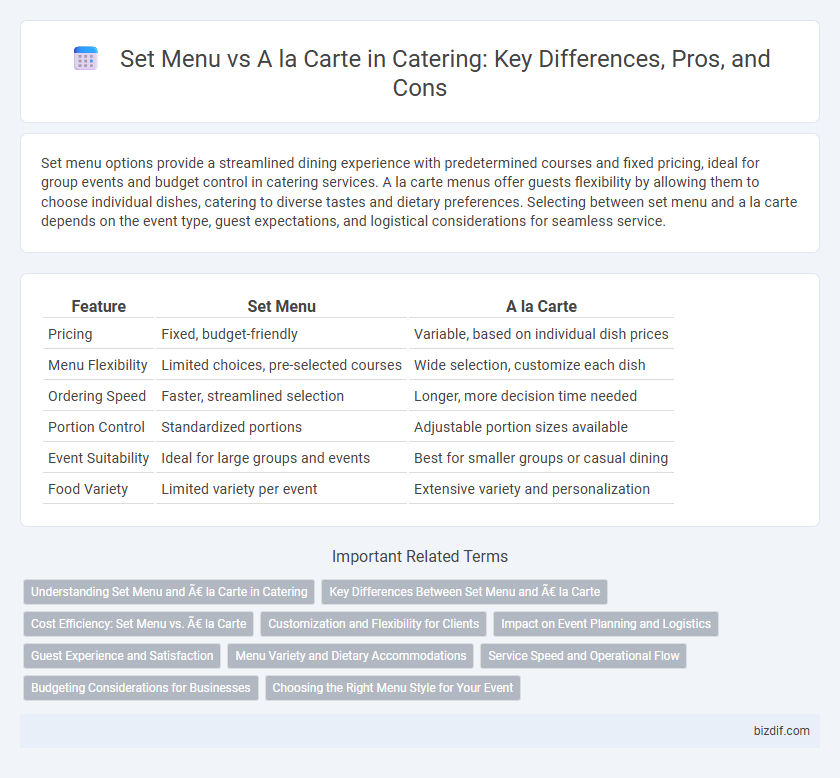Set menu options provide a streamlined dining experience with predetermined courses and fixed pricing, ideal for group events and budget control in catering services. A la carte menus offer guests flexibility by allowing them to choose individual dishes, catering to diverse tastes and dietary preferences. Selecting between set menu and a la carte depends on the event type, guest expectations, and logistical considerations for seamless service.
Table of Comparison
| Feature | Set Menu | A la Carte |
|---|---|---|
| Pricing | Fixed, budget-friendly | Variable, based on individual dish prices |
| Menu Flexibility | Limited choices, pre-selected courses | Wide selection, customize each dish |
| Ordering Speed | Faster, streamlined selection | Longer, more decision time needed |
| Portion Control | Standardized portions | Adjustable portion sizes available |
| Event Suitability | Ideal for large groups and events | Best for smaller groups or casual dining |
| Food Variety | Limited variety per event | Extensive variety and personalization |
Understanding Set Menu and À la Carte in Catering
A set menu in catering offers a fixed selection of dishes at a predetermined price, allowing for streamlined service and easier budgeting. A la carte provides guests the flexibility to choose individual dishes from an extensive menu, catering to diverse preferences and dietary needs. Understanding the balance between set menu efficiency and a la carte customization is essential for delivering optimal dining experiences in event catering.
Key Differences Between Set Menu and À la Carte
Set menus offer a fixed selection of courses at a predetermined price, ensuring streamlined service and cost efficiency for catering events. A la carte allows guests to choose individual dishes from an extensive menu, providing greater customization and variety but often resulting in higher costs and longer preparation times. Key differences include pricing structure, menu flexibility, portion control, and the overall dining experience tailored to event preferences.
Cost Efficiency: Set Menu vs. À la Carte
Set menus offer significant cost efficiency by allowing caterers to streamline ingredient purchasing and reduce food waste through standardized dishes. A la carte options may increase overall costs due to ingredient variety and preparation complexity, leading to higher labor and supply expenses. Choosing set menus optimizes budgeting while maintaining menu control and service speed.
Customization and Flexibility for Clients
Set menus offer streamlined options that simplify planning and ensure consistent portion control, ideal for events with fixed preferences and budgets. A la carte dining provides maximum customization, allowing clients to tailor each dish to individual tastes and dietary needs, enhancing guest satisfaction. This flexibility lets clients mix and match menu items, catering to diverse palates and creating a personalized dining experience.
Impact on Event Planning and Logistics
Choosing between a set menu and a la carte significantly influences event planning and logistics by affecting preparation time, staffing needs, and budget management. A set menu streamlines kitchen operations and inventory control, reducing waste and allowing for precise headcounts, while a la carte offers customized dining experiences that demand flexible kitchen workflows and increased staffing to handle diverse orders. Event planners must weigh the trade-offs between efficiency and guest personalization to ensure seamless service and optimal resource allocation.
Guest Experience and Satisfaction
Set menus streamline the dining experience by offering a curated selection of dishes, ensuring consistency in quality and efficient service that enhances guest satisfaction. A la carte provides personalized choices, allowing guests to tailor their meals to individual tastes, which can elevate the sense of luxury and attention to detail. Balancing these options in catering services can optimize guest experience by meeting diverse preferences and dietary needs while maintaining operational efficiency.
Menu Variety and Dietary Accommodations
Set menus streamline catering by offering fixed meal options, ensuring consistency but limiting menu variety and customization for dietary restrictions. A la carte menus provide diverse choices, enabling guests to select dishes that accommodate specific dietary needs such as gluten-free, vegan, or allergen-free options. Catering services benefit from balancing set menus for efficiency and a la carte selections to enhance guest satisfaction through personalized dietary accommodations.
Service Speed and Operational Flow
Set menus streamline service speed by minimizing order customization, allowing kitchen staff to prepare dishes in advance, which enhances operational flow and reduces wait times. In contrast, a la carte dining requires personalized preparation for each order, potentially slowing service and complicating kitchen logistics. Choosing a set menu optimizes catering efficiency, especially for large events where consistent timing is crucial.
Budgeting Considerations for Businesses
Set menus offer businesses predictable food costs and streamlined inventory management, helping to control overall catering budgets more effectively than a la carte options. In contrast, a la carte menus provide flexibility for guests but can lead to fluctuating food expenses and increased complexity in supply purchasing. Careful analysis of guest preferences and event scale is essential to balance cost efficiency with customer satisfaction in catering budgeting.
Choosing the Right Menu Style for Your Event
Selecting between a set menu and a la carte significantly impacts the flow and budget of your catering event. Set menus offer streamlined service and cost efficiency by providing predetermined dishes, ideal for large gatherings or formal occasions. A la carte allows guests personalized choices, enhancing flexibility and culinary experience, which suits intimate or diverse events.
Set menu vs à la carte Infographic

 bizdif.com
bizdif.com